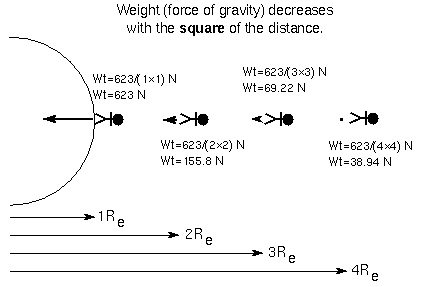
Video lecture for this chapter
Newton's law of gravity describes a force that decreases with the SQUARE of the distance. For every factor of 2 the distance increases, the gravitational attraction decreases by a factor of 2 × 2 = 4; for every factor of 3 increase in distance, the gravity decreases by a factor of 3 × 3 = 9 (not by 3 + 3 = 6!); for every factor of 4 increase in distance, the gravity decreases by a factor of 4 × 4 = 16 (not by 4 + 4 = 8!), etc. See the mathematics review appendix for a review of ``factor'' and ``times''. Some more examples are given in the table below. Notice how quickly an inverse square law gets very small.
| distance | inverse | inverse square |
|---|---|---|
| 1 | 1/1 = 1 | 1/12 = 1 |
| 2 | 1/2 = 0.5 | 1/22 = 1/4 = 0.25 |
| 3 | 1/3 = 0.33 | 1/32 = 1/9 = 0.11 |
| 4 | 1/4 = 0.25 | 1/42 = 1/16 = 0.0625 |
| 7 | 1/7 = 0.14 | 1/72 = 1/49 = 0.02 |
| 10 | 1/10 = 0.1 | 1/102 = 1/100 = 0.01 |
| 100 | 1/100 = 0.01 | 1/1002 = 1/10,000 = 0.0001 |
Example: Joe Average has a mass of 63.5 kilograms, so he weighs 623 newtons (=140 pounds) on the Earth's surface. If he moves up 1 Earth radius (= 6378 kilometers) above the surface, he will be two times farther away from the Earth's center (remember that distances are measured from center-to-center!), so his weight will be four times less, or 623/4 newtons = 155.8 newtons (= 140/4 pounds); NOT two times less, or 623/2 newtons = 311.5 newtons. If he moves up another Earth radius above the surface, he will be three times farther away than he was at the start, so his weight will drop by a factor of nine times, NOT 3 times. His weight will be 623/9 newtons = 69.22 newtons (= 140/9 pounds); NOT 623/3 newtons = 207.7 newtons. His mass will still be 63.5 kilograms. Figure below illustrates this.
Let us generalize this for any situation where the masses do not change: the force of gravity at distance A = (the force of gravity at distance B) × (distance B / distance A)2. Notice which distance is in the top of the fraction! To use this relation, have the gravity at distance A represent the unknown gravity force you are trying to find and the gravity at distance B represent the reference gravity force felt at the reference distance B.

How do you do that?Let's find where the weight values in the inverse square law figure come from.For Mr. Average's case the reference weight is his weight on the surface of the Earth = 623 N. His weight at 6378 kilometers above the surface is gravity at A = 623 × [6378/(2 × 6378)]2 = 623 × 1/22 = 623 × 1/4 = 155.8 N. When he is at two Earth radii above the surface, the gravity at A = 623 × [6378/(3 × 6378)]2 = 623 × 1/32 = 623 × 1/9 = 69.22 N. |
![]() Go back to previous section --
Go back to previous section --
![]() Go to next section
Go to next section
last updated: 11 May 2001